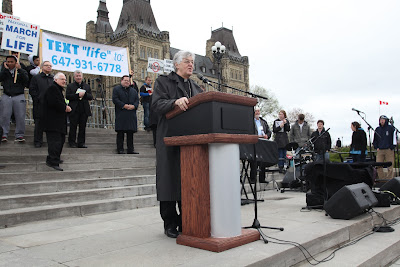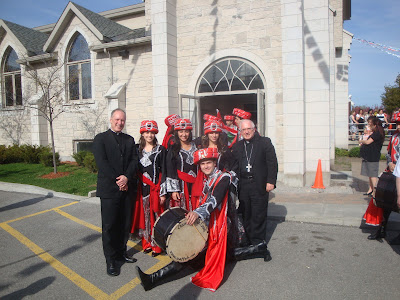The Solemnity of the Ascension (Year “B”)—May 20, 2012
[or Ascension Thursday, May 17, 2012]

THE ASCENSION AS END AND BEGINNING
[Texts: Acts 1.1-11 [Psalm 47]; Ephesians 4.1-13; Mark 16.15-20]
The last twelve verses of Mark's gospel (16.9-20) are known as the Longer, "Canonical" Ending. While these verses are recognized by the Church as illuminating Christian faith and remain normative for subsequent generations, Mark almost surely did not pen them.
The Greek word ‘kanon’ means a ‘measuring rod’ and suggests a ‘rule of faith’ when used of ‘normative’ writings chosen by Church authorities for inclusion in the New Testament. What is true of the Longer Ending of Mark applies also to a two-verse Shorter Ending printed at the close of the gospel.
Manuscript traditions show the Longer and Shorter Endings of Mark attempting to overcome the abrupt ending of Mark 16.8, whether the evangelist intended to end his gospel this way or a part of the original gospel was lost.
Close inspection of the verses in the Markan Longer Ending shows that they contain a pastiche of appearances by the Risen Jesus found in other gospel traditions.
Thus, the apparition to Mary Magdalene in Mark 16.9 echoes John 20.11-17 (with a possible allusion to Luke 8.2), while Mary's role as messenger in Mark 16.10 parallels what we find in John 20.18. The disciples' unbelief—Mark 16.11, 13—perhaps derives from Luke 24.11-41, whereas the appearance “in another form to two of them, as they were walking into the country” (16.12) recalls the journey to Emmaus (cf. Luke 24.13-35).
Jesus' rebuke of the Eleven's unbelief while they were at table (Mark 16.14) evokes John 20.24-29, and the evangelising commission (Mark 16.15) may reflect Matthew 28.19 or Luke 24.47. The description of the Ascension (Mark 16.19) may allude to Luke 24.50-51 or suggest the theology of Jesus' presence at God's right hand found throughout the Epistle to the Hebrews (beginning with 1.3, 13).
Those parts of the Longer Ending not accounted for (Mark 16.16-18, 20) go beyond Jesus' Resurrection and Ascension to speak of the Church's missionary preaching activity. Mark 16.16 stresses that faith and baptism guarantee salvation, likely drawing on the Lord's command to baptize found in Matthew 28.19-20.
A virtual summary of the Acts of the Apostles is found in Mark 16:20: “and they went out and proclaimed the Good News everywhere, while the Lord worked with them and confirmed the message by the signs that accompanied it”.
Mark 16.17-18 lists some ‘signs’ found in the Acts of the Apostles. An oddity is the reference to disciples surviving snake handling (possibly a reference to Paul's experience in Acts 28.3-6) and withstanding the effects of poisonous drinks as ongoing characteristics of Jesus' followers. The word for ‘snake’ is the same one found in the Greek Old Testament (the Septuagint) in the account of the serpent's temptation (Genesis 3.1-15). Perhaps a metaphorical meaning should be inferred, that the curse of the serpent has been overcome in the age of salvation.
Mark 16.9-20 has a notable collection of words not found in the rest of the gospel, giving the Longer Ending a second-hand flavour. Indeed it departs notably from the lively style found elsewhere in Mark 1.1-16.8. Still the canonical conclusion serves as a sequel to Mark's ending by communicating the conviction that the promises made by Jesus in Mark 14.28 and 16.7—of his ongoing relationship with the disciples in Galilee and beyond—were realized in the life of the Church.
The secondary ending stresses the call to Jesus' disciples to pass from disbelief to belief about the resurrection. The witnesses who reproach their stubbornness of heart increase in number and authority: from Mary of Magdala, to the two travellers to Jesus Himself.
A later addition to Mark 16.14 shows that the early Church struggled with issues such as sin and temptation blaming its disobedience in part on the Devil: “And [the apostles] made excuse, saying, ‘The age of lawlessness and unbelief is under Satan who does not permit the truth and power of God to prevail over the unclean things of the spirits. Therefore, reveal your righteousness, now’”.
Jesus' reply to the disciples' struggle noted that, while Satan's authority had been exhausted and other terrible things approached, his death took place so that people might “return to the truth and sin no more, that they may inherit the spiritual and imperishable glory of righteousness that is in heaven”.
While the Longer Ending of Mark appears incongruous, it recalls that the church remains a believing, confessing and worshipping community, as it was from the beginning after Jesus' Ascension.
* * * * * *
PRIESTLY ORDINATIONS OF
CRAIG CAMERON
& GERARD RYAN, SJ
This is the season for priestly ordinations and I rejoice particularly in the ordinations of two men I have gotten to know over the years. The first is Father Craig Cameron, who will be ordained Saturday by Archbishop Anthony Mancini.
 |
| Father Craig Cameron will be ordained as the first priest of the newly-amalgamated Archdiocese of Halifax-Yarmouth at St. Mary's Cathedral-Basilica, Halifax at 10 o'clock on May 19, 2012 |
The second ordinand is a fellow Jesuit, Gerard Ryan, whom I will ordain at Toronto's Our Lady of Lourdes Church the same day.
 |
| Gerard Ryan, SJ (right), a native of Tipperary, Ireland, will be ordained for the Province of the Jesuits in English Canada on Saturday, May 19, 2012 at 10 o'clock. |
Congratulations to them and to others being ordained to the priesthood in these days; may they have long and fruitful ministry in the Lord's vineyard!
Ad multos et faustissimos annos!






































